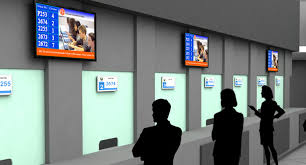In today’s fast-paced environment, efficient service delivery is the backbone of successful businesses, especially in countries with growing urban centers like Pakistan. One of the most pressing challenges for businesses and government institutions is managing long queues and wait times. Enter the Queue Management System (QMS)—a technological solution designed to streamline customer flow, reduce wait times, and enhance service experience.
This blog explores the importance, implementation, and benefits of queue management systems, focusing especially on Islamabad and other major cities in Pakistan. Whether you run a hospital, bank, telecom office, or any service center, a QMS is no longer a luxury—it’s a necessity.
What is a Queue Management System?
A Queue Management System is a set of tools, often digital, designed to manage and streamline the flow of people waiting in lines. Instead of chaotic and long-standing queues, QMS offers an organized structure where customers are issued a token and are called according to their turn.
Key Functions of a Queue Management System:
-
Token generation (manual or digital)
-
Real-time customer data tracking
-
Queue prioritization (e.g., elderly or disabled customers)
-
Service performance analytics
-
Feedback collection
Why Businesses Need a Queue Management System
1. Improved Customer Satisfaction
When customers wait in chaotic lines, frustration builds. With a QMS, customers can relax while waiting, knowing they’ll be called in order. This elevates their overall experience.
2. Enhanced Staff Productivity
Without the stress of handling impatient customers, staff can focus on delivering quality service. A QMS automates much of the process, freeing up employees.
3. Data-Driven Decisions
Many QMS platforms come with analytics dashboards that provide insights into customer flow, peak hours, and employee performance—allowing businesses to make informed decisions.
How Queue Management Systems Work
Here’s a simplified step-by-step of how QMS works:
-
Token Issuance: Customers receive a token either from a kiosk or a mobile app.
-
Digital Queue: The system queues customers digitally.
-
Notification: Customers are notified of their turn via display screens or SMS.
-
Service Delivery: Staff calls the customer when ready.
-
Feedback Collection: After service, customers can rate their experience.
Queue Management System in Islamabad
Islamabad, being the capital of Pakistan, is a hub for government services, embassies, banks, and hospitals. The implementation of queue management systems in Islamabad has become increasingly common to cope with the growing demand for efficiency.
Popular Venues Using QMS in Islamabad:
-
NADRA Registration Centers
-
Passport Offices
-
Hospitals like PIMS and Shifa International
-
Telecom Service Providers (Jazz, Telenor)
-
Private Banks (UBL, MCB, HBL)
Government Adoption
Various government offices in Islamabad now use digital queue systems to manage foot traffic, reduce waiting time, and enhance transparency.
Queue Management System in Pakistan
Across Pakistan, from Karachi to Lahore to Peshawar, organizations are increasingly realizing the value of implementing modern queue management systems.
Common Use-Cases in Pakistan:
-
Healthcare: Reducing patient wait time and streamlining appointments
-
Banking: Managing peak time crowds and personal appointments
-
Telecom: Handling SIM verifications, billing issues, etc.
-
Education: Admission offices and student facilitation centers
-
Retail: Handling customer service and billing queues
Types of Queue Management Systems
1. Manual Queue Systems
Old-school systems where a staff member manages the queue. Cost-effective but error-prone and inefficient.
2. Digital Token Systems
Automated kiosks issue tokens. Common in hospitals and banks.
3. Mobile App-Based QMS
Modern systems where users join queues remotely through apps. Highly convenient and preferred in urban areas.
4. Cloud-Based QMS
Offered as SaaS (Software as a Service). No need for heavy infrastructure—perfect for scaling.
Benefits of a Queue Management System
| Benefit | Description |
|---|---|
| Reduced Wait Times | Automated queues streamline the customer flow. |
| Improved Accuracy | No human error in managing queue order. |
| Real-Time Monitoring | Track peak hours and employee performance. |
| Better Resource Allocation | Assign more staff during busy hours. |
| Enhanced Customer Loyalty | Happier customers are more likely to return. |
Key Features to Look for in a QMS
-
Multi-Channel Token Generation
-
Customizable Queues
-
Live Queue Status
-
SMS/Email Alerts
-
Service Ratings and Feedback
-
Dashboards and Reports
Industries That Benefit from QMS
Healthcare
Patients no longer need to stand in line for hours. Hospitals use QMS to organize consultations and emergency room traffic.
Banking
Reduces congestion in bank branches. Offers token-based or appointment-based services.
Telecom
Handles massive customer volumes, especially during SIM re-verification and billing disputes.
Government Offices
Boosts transparency and efficiency in high-demand offices like passport centers and NADRA.
Case Studies of QMS in Pakistan
NADRA Islamabad
The introduction of QMS has significantly improved the application and renewal process. Citizens now get a token and can monitor their turn via LED screens.
Shifa International Hospital
Introduced QMS for OPD departments, reducing chaos and improving doctor-patient coordination.
Jazz Customer Centers
QMS reduced wait time by 40%, with feedback options helping improve service quality.
Challenges in Adopting QMS in Pakistan
1. Digital Literacy
Not all customers are tech-savvy, especially the elderly.
2. Infrastructure Limitations
Some areas lack stable internet or electricity, making digital QMS adoption difficult.
3. Initial Costs
High upfront investment, although ROI is generally positive long-term.
Future Trends in Queue Management Systems
1. AI Integration
Artificial Intelligence can predict queue volumes and adjust staffing in real-time.
2. Omnichannel Queues
Customers will be able to join queues via mobile apps, websites, and kiosks simultaneously.
3. Biometric Verification
Integration with biometric data to enhance security and personalization.
4. Touchless Queues
Post-COVID, more organizations are adopting touchless and voice-enabled queue systems.
How to Choose the Right QMS Provider
-
Look for experience and reputation in the Pakistani market
-
Ensure 24/7 support and training services
-
Consider scalability for future business expansion
-
Ask for customization options based on your industry
-
Prefer providers that offer analytics and dashboards
Conclusion
A queue management system is more than a token dispenser—it’s a powerful tool that improves efficiency, boosts customer satisfaction, and enables data-driven management. Especially in urban centers like Islamabad and other parts of Pakistan, adopting a QMS is no longer optional—it’s essential for maintaining service excellence in today’s competitive landscape.
FAQs
1. What is a queue management system?
A queue management system is a tool that organizes customer queues digitally, reducing wait times and improving service flow.
2. How does a queue management system work?
It issues tokens (via kiosk or app), digitally manages queues, and notifies customers of their turn through screens or messages.
3. Where are queue management systems used in Islamabad?
They are commonly used in government offices, hospitals, telecom centers, and banks across Islamabad.
4. What is the cost of installing a QMS in Pakistan?
Costs vary depending on features and scalability, ranging from PKR 100,000 for basic systems to PKR 1,000,000 for advanced setups.
5. Can small businesses in Pakistan afford a QMS?
Yes, cloud-based and app-based QMS solutions are cost-effective and scalable for small businesses.







0 Comments